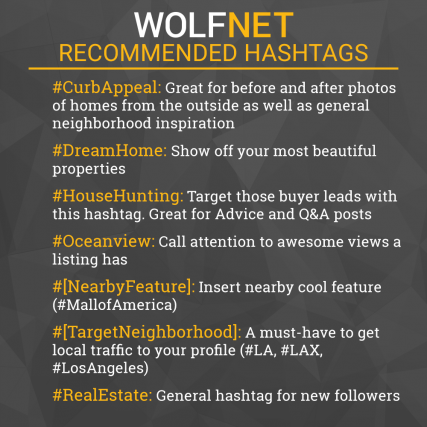You are viewing our site as an Agent, Switch Your View:
Agent | Broker Reset Filters to Default Back to ListIncrease Your Social Media Engagement with These 5 Best Practices
October 03 2018
 Whether you're showing off an awesome listing or sharing a neighborhood guide, using social platforms to their fullest will undoubtedly help grow your real estate business.
Whether you're showing off an awesome listing or sharing a neighborhood guide, using social platforms to their fullest will undoubtedly help grow your real estate business.
From the fast-paced conversations on Twitter to the hours spent watching YouTube and Facebook live videos, social media is becoming an extremely popular avenue for buyers to learn more about the brands and businesses they're interested in.
Social media is also a new frontier for many real estate agents: According to a 2017 study by the National Association of Realtors, only 26 percent of agents are extremely comfortable using social media, so now is the time to get online and get up to speed with social media!
There are many best practices for growing social media engagement out there, and here we highlight some of the most crucial best practices for agents to stay top-of-mind as you post, tweet, share and comment your way to the top!
Best Practice #1: Use the Right Hashtags
These days, almost every social platform utilizes hashtags—even LinkedIn! Using the right types of hashtags on the right platforms is important to maximizing the benefits of this helpful search tool.

Hashtag Rules by Platform
Any word with a pound sign (#) before it becomes a hashtag on Twitter—except hashtags can't include spaces or punctuation. Hashtags are used as searchable keywords, and when you use them, your posts show up when someone searches the hashtag on Twitter. You can search hashtags by typing any keyword you want into the search bar of Twitter. While Twitter allows you to use as many hashtags as you want, best practice is to stick to one to two per tweet. Keep your hashtags short – use #NYHome not #NewYorkHomeForSale. Stay on top of weekly hashtags like #ThrowbackThursday/#TBT as well as seasonal or holiday hashtags to keep up with the ever-evolving Twittersphere.
Facebook is a great place to interact with local communities and groups, so use all of the locally-oriented hashtags to get eyes from your target markets here. Make your hashtags more readable by capitalizing the first letter of each word—#NewYork, not #newyork. Just like Twitter, best practice is to use only one to two hashtags per post to minimize overcrowding and distraction. Because you only have 1-2 hashtags to use, pick the hashtags that are the most relevant to your post—going with one general (#realestate) and one specific (#CharlotteHome) will help you reach both broad and specific audiences. You can search hashtags on Facebook in two ways: by typing them in the search bar or by visiting facebook.com/hashtag/x (insert your hashtag in the x section).
You can use up to 30 hashtags with no penalty on Instagram, so it's full steam ahead! Just make sure to put them at the bottom of the post, and try to use specific hashtags that pertain to your state, neighborhood and/or type of property for sale, as well as a mix of more general hashtags like #NewHome #Property or #RealEstate. Go a step above and create your own hashtag, like #FirstnameLastnameAgent so that users can easily search your available posts.
YouTube
While YouTube doesn't use hashtags, they do use video tags. Adding a few helpful tags like home tour, one bedroom apartment, and other specific tags will give your video a boost and make sure it's seen by more viewers. Another tip: try searching for similar videos to yours before you post and grab some of their (relevant) hashtags: if their video came up on page one, their keywords are probably well-optimized!
Best Practice #2: Pre-Schedule Your Posts
Being active on several social channels can take up a lot of time, especially if you open your various apps individually each day and post the same post in different formats. Get the repeat posting time-suck out of your life and use one of many social scheduling tools like Hootsuite, Buffer, AgoraPulse, or Sprout Social to bulk pre-schedule your posts. These tools allow you to schedule the same post on many platforms as well as schedule it on repeat, saving you a ton of time.
Pre-scheduling is useful in many different situations. From posting relevant real estate advice while you're on vacation to setting up a month-long campaign to promote a few select listings, social prescheduling can save you some time and ensure that your content gets posted at the best time for your audience.
Reposting something, especially something useful like a blog post or other resource isn't obnoxious, especially if you use a different image and tagline to change it up. Reposting something once a week is totally fine—keep in mind that many of your followers probably didn't see it the first time, so it's okay to post it again.
On social media, consistency is key. Maintaining an active and consistent presence on the various social platforms can mean posting anywhere from once to 15 times per day—and using a social scheduling tools can help you do just that without breaking the time bank. Happy scheduling!
Best Practice #3: Add Visual Intrigue
They don't call it social media for nothin': Tweets with images receive 150 percent more retweets than tweets without images. Both Facebook and Twitter see higher engagement rates for posts/tweets with images: Facebook posts with images see 2.3x more engagement than those without images, and tweets with image links get 2x the engagement than those without. Whoa! People really like pictures.
Add visual intrigue to your posts by attaching a photo, branded graphic, video, or infographic. Whether you take the image yourself or find it on a free stock photo site like Unsplash, Pexels, or Pixabay, adding the image will definitely up your post engagement. To create templates that make it easy to add unique branding to your images, try Canva, PicMonkey, or Easel.ly.
Videos don't have to be difficult (and they can really ramp up engagement on social: Facebook users alone watch 8 billion videos per day). From the simple homes for sale slideshow to the detailed neighborhood FAQ, videos spice up your social content and get you those clicks, likes, and comments.
Read 3 Types of Videos that Generate High Quality Leads to learn what kinds of real estate content you can make to draw in new leads.
Best Practice #4: Respond Promptly to Positives and Negatives
If someone takes time out of their day to leave you a review or comment, whether positive or negative, it is best practice to respond promptly—sometime within the next 24 hours, if possible.
The reason you need a speedy response is twofold: 1) it shows your audience you care about them and 2) it protects your brand and reputation. For negative reviews or comments, make sure to respond with a non-confrontational tone, and offer them a chance to talk their grievances over with you. Most importantly, try to have the actual conversation take place in a private format (i.e., either via a direct message, via email or over the phone). Acknowledge publicly; respond privately. This allows everyone in your network to see that you acknowledge when things may not be perfect, and it allows your commenter privacy to air their grievances.
For positive comments and reviews, express your gratitude that they follow you and leave them a short message acknowledging their positive feedback. Responding to reviews and comments can really help grow your engagement because it encourages people to comment on your posts—when they know they will get a reply, they will feel more inclined to ask questions and engage with you online.
Best Practice #5: Post a Variety of Content
Your social media presence should represent everything about your brand—not just home listings or house-buying tips. Consumers want to see Q&A sessions, blog post shares, videos, funny posts, real-life photos of you and your team, and more. Posting varied content and even sharing content from outside, non-competitor sources can help drive likes and clicks. Of course, not everyone wants the same information. Some people are looking to buy homes in a certain neighborhood while others could really use how-tos on how to sell their homes. Others just want to know which events you're attending so they can meet you in person. Keeping your posts varied insures that no one will get bored of your awesome content.
Master of Engagement Status Achieved
You're primed and ready to be a social media superstar. A master of hashtags, pre-scheduled posts, interesting visuals, upbeat responses, and a variety of content, you're ready to engage your audience and make some sales while doing it. Go forth and use these social media best practices to attract likes, clicks, and comments on your useful posts.
Want more social media info? Get our roundup of social media influencers in real estate or find out 5 ways to drive real estate leads on Facebook.
To view the original article, visit the WolfNet blog.









